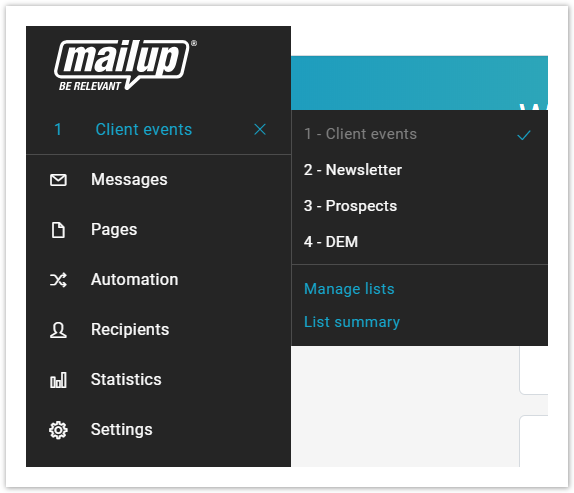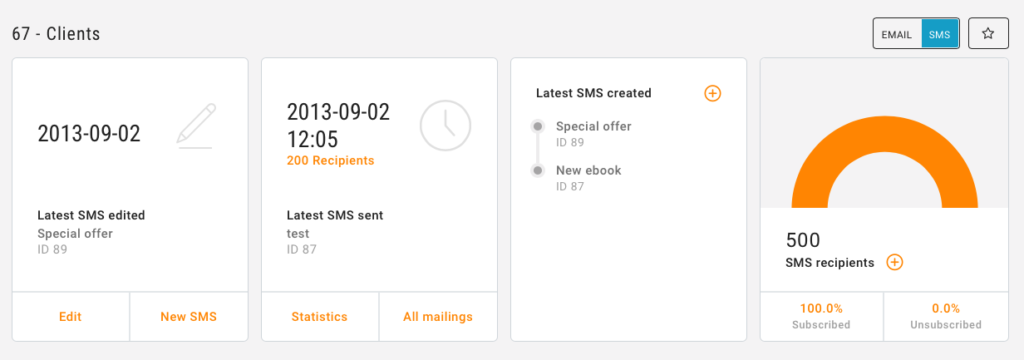From mailing lists to segments: the evolution of the database and the new MailUp dashboard

The concept of mailing lists has accompanied Email Marketing since its inception. But too many companies still consider mailing lists an indistinct set of email addresses today.
This concept is quite obsolete and outdated now. Email Marketing has evolved, just as the approach to mailing lists has evolved: they are no longer seen as undifferentiated organisms, but as open, composite, diversified systems.
Today we’ll shed light on this themeto understand how the concept of mailing list has evolved into segments list.We were inspired to do so by a newfeature that was just added to the MailUp platform which is useful forimproving the multi-listmanagement of your strategy.

From developing integrations to strategic support, from creating creative concepts to optimizing results.
Recipient lists, yesterday and today
As we mentioned, until a few yearsago, the mailing list was conceived as a single container of recipientaddresses to which the sender sent the same email. Americans effectively callthis approach one size fits all.
Unanimously considered outdated,this approach has given way to a more articulated view of the mailing list,seen as a body stratified into groups and segments, created by companies to diversify mailings and,consequently, send campaigns in line with the features, interests, and needs ofeach recipient.
As you’ll have understood, in marketing (and not just Email Marketing) today segmentation plays a key role, that activity that leads companies to divide their audience into segments ranging from highly complex to rather simple: segments can be understood as broad groupings – promotional DEMs, newsletters, or other types – but also more focused subdivisions, for example by geographical area or by product interest.
But let’s take a look at a morepractical way in which MailUp supports segmentation.
How do MailUp lists work?
To support the evolution from theconcept of mailing lists to segments list, MailUp has always provided companieswith multi-list environments,offering the possibility to create different mailing lists within the sameplatform; each of these lists has an autonomous management system with itsown recipients, its own descriptions, preferences, and types ofcommunication.

Not only that, because the list inMailUp is in turn a container that can be subdivided internally into infinite groups, so as to createdifferent mailing categories. Let’s look at a few examples:
- Newsletters
- Promotions
- Potential customers
- Top customers
- Frequent customers
- Casual customers
- Inactive customers
- Foreign market.
These are just a few examples, butthe case studies can be endless, and are directly dependent on the peculiarities of each business. Forexample, an agency mayneed to create a list for each company-client, so that it can have a separateenvironment in which to manage recipients and templates and consult statisticalreports of each individual customer.
As you will have understood, thelists allow a better structuring of the recipients and the database: in fact itis like having multiple platformsin one, with the advantage of making each mailing more targeted andconsequently more performing.
You will also find a valuablesupport for managing each list on the platform: the dashboard, and now we’ll explain it further.
What is a dashboard?
The dashboard (also available in themobile version) is the page that appears when you access one of your lists, andgives you an overview of youractivities thanks to some valuable information:
- Mailingvolumes,thanks to a graph showing the number of emails or SMS messages sent in the lastsix months
- Lastmailing,with the statistics of the last message sent, divided by openings and clicks:by clicking on it you can access the respective detailed report (a click on theemail subject lets you see a preview or edit the message)
- Scheduledmailings calendar,to always have your email scheduling under control, knowing the date and timeit’s set to send
- Mailingsin progress,to know which email campaigns are being launched
- Last messagesmodified,date and time of the last modification; clicking on the subject lets youpreview or edit the message
- Listdetails,which contains the main information, with the possibility of changing the listpreference (i.e. that opened automatically after logging into the platform)
- Recentmailings,with the number of mailings, openings and unique clicks of the last fivemessages sent in the last 90 days to more than 100 recipients
- The device graph that lets you understand where youremails are opened (on desktop or mobile).
This is the dashboard for a singlelist. And if you have a multi-listplatform? Starting today you’ll find a new function.
New! The summary dashboard
With the aim of integrating thedifferent lists of a company, we have added a new dashboard to the platformwhich offers a summary, a valuable comparisonof different lists.
To access it just go to the sidemenu and click on the drop-down menu of the lists: you will find Lists summary (you canalso select Compare your lists in the cover image).

Once inside, you can select up to five lists to havean overall picture of all your activities and strategies, with variousinformation that can be easily consulted and compared.

For each list selected, you’ll see adashboard including:

Last modified message
With the possibility of accessing, with a click, the email’s modification or summary page; or even create a new email or access the list of created messages.

Statistics last 30 days
You will find the open, unique click, and delivery rates (alongside the variations compared to the previous 30 days). Then, in addition to a summary of the recipients reached and the number of emails sent, you will find a small report that identifies the messages that stand out for their open rates and clicks, with the relative numbers.

Recipients
This shows the total number of recipients registered in the list and the percentage of subscribed, pending, and unsubscribed recipients compared to the total. Just one more click and you can also directly access the page where you can import new contacts.

Does your company also do SMS Marketing? If you’ve modified or sent an SMS message in the last 90 days and have credits available, you’ll find an overview with:
- Last SMS modified, with thepossibility to modify it or create a new message
- Last SMS delivered, number ofrecipients, and access to statistics or the list of messages
- Timeline of the last messagescreated, with the possibility of creating a new one
- Total recipients subscribed to thechannel and percentage of subscribed and unsubscribed recipients compared tothe total.
To access the summary of the SMS channel, just select SMSat the top right of the list.
The star you see on the side, on the other hand, allows you tomake that list your favorite, which will be opened automatically every time youlog into the platform.
In summary
Email Marketing is increasingly a question of knowing how to communicate effectively with the right message to the right recipient. The challenge of segmentation is increasingly fundamental, whether the subdivision is complex or even just basic groups.
The advice is to start understanding how a multi-list platform like MailUp works: you can do so today by requesting a free 30-day trial of the platform, to start creating, segmenting, sending, and tracking your email campaigns.